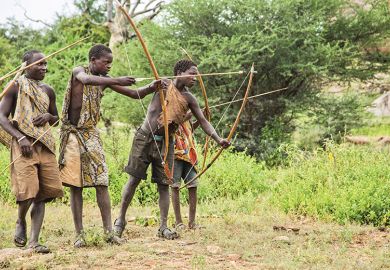The subject of the shrinking worlds of tribesmen and their disappearing traditions has become such a cliche that it is almost impossible to avoid hearing vaguely sympathetic and bland comments on these "quaint" people. Whatever the truth in the tribal world, the modern world seems to believe only what it chooses.
Tribal Asia tries to uncover and highlight the similarities and differences between the strange worlds of the so-called unique tribes living throughout Asia, using lavish photographs with brief commentaries on their sociopolitical histories. The book is a panoramic view of tribal worlds from the Arab Bedouin of western Asia to Tanimbar in the Indonesian archipelago. Both their attractions and their peculiarities are captured.
The authors rightly note that the ways of life and cultures of the tribes have not stood still over the centuries, and that "this kind of lack of understanding of other cultures is not something which is restricted to Westerners as they look at their tribal brethren, but is something that is also common between the tribal groups".
Even now, though, the portrayal of these tribes has not changed much since they were discovered by Westerners a few centuries ago. Whenever I read a book such as this, I feel it inadvertently encourages readers to collect "quaint" tribal artefacts before they disappear, rather than urging them to understand apparently outlandish ways of living. Moreover, the tribesmen and women are recorded in a way that cannot help but recall the "noble savage" formula - which undermines the intention of the authors in wishing to enlighten those who have forgotten their prelapsarian inheritance.
Most of the book's commentaries are concise and thought-provoking, but they sometimes seem to come from travel brochures of the kind that turn tribal traditions into entertainment. Take the description of the generic name of my tribe, the Padaung of Burma, known for our "giraffe women" (because they wear multiple metal rings around their necks): " Pa means 'roundabout' and daung is the word for all sorts of shining metal." No one in Burma, not even us Padaung, knows the exact meaning and origin of our name; in any case, we call ourselves "Kayan".
Whatever our external description, seen from the inside, we tribal people are a strange bunch living on the edge of survival. Genetically we may belong to a major race, but we do not like to be identified with it because we think we are not part of the crowd. Tribesmen tend to describe themselves in terms that imply that only they are the real human beings.
The authors also argue that "tribal people do nothing that is superfluous, because any waste of resources and energy can be life-threatening". But it is not only tribal people who think like this. What about a company's board of directors, which must adopt a frugal strategy to survive extreme circumstances?
The reason why tribal people learn to utilise nature more than their developed world counterparts is because they are used to fewer physical restrictions and have less technical know-how, so they enjoy the pleasures and endure the pains imposed on them by Mother Nature more acutely, without the leisure to philosophise. Seen in this way, Tribal Asia offers readers a bizarre, tantalising and sensuous review of the tribal worlds that have been almost forgotten by our overexploited and organised modern society.
Pascal Khoo Thwe is the author of From the Land of Green Ghosts: A Burmese Odyssey .
Tribal Asia: Ceremonies, Rituals and Dress
Author - Robert Schmid and Fritz Trupp
Publisher - Thames and Hudson
Pages - 319
Price - £39.95
ISBN - 0 500 54285 6
Register to continue
Why register?
- Registration is free and only takes a moment
- Once registered, you can read 3 articles a month
- Sign up for our newsletter
Subscribe
Or subscribe for unlimited access to:
- Unlimited access to news, views, insights & reviews
- Digital editions
- Digital access to THE’s university and college rankings analysis
Already registered or a current subscriber?



